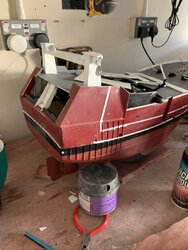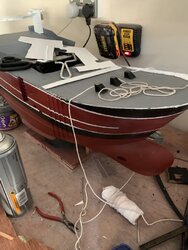Because of the paint issue, I can't really do much on the car below the main rails, so I've turned my attention to the stuff "up top" so that I'm not twiddling my thumbs.
The next stage there is the roll cage. It looks straightforward, but isn't, as there are sections of it that aren't all in the same plane and / or have some fairly complex shapes. Made a jig out of a piece of old floorboard, with the cage footprint marked out, and holes to take the wire pegs, so that I can work separately to the chassis, and then, eventually, simply drop the completed driver's cab onto the rails.
Started out by making a set of drawings (more about that later) and then got stuck into the two pieces that are totally perpendicular to the chassis rails. The bit at the front of the cage is fairly simple i.e. rectangular, hole in the middle and with fillets in the corners, so I just drew as many layers as I needed on a piece of card, cut them out and stuck them together, laminating in the two locator pegs on the bottom as I went along. The other section is much more complicated - a sort of hexagon with sections cut out of it, so I made that using the drawing as a template and then pricking through that onto the card below with mum's lace making awl. This section got modified during the making to take the slope of the roof rails into account, so the sections got progressively shorter with each layer. Plus the usual wire pins got laminated in.
I've been using 2-part epoxy rather than superglue (except for the wire pegs - epoxy doesn't hold them in place well enough) to avoid the allergy issues. Epoxy is definitely messier than superglue, and takes longer to dry. And then there's that fine line between mixing enough glue to do what you need to do, but it not starting to set on you...
Needed to make some of the sections that slope in two different directions, so the layers for those were cut to size for one of the angles, laminated with paper glue (pritt stick) and then, using the drawing as a guide, I could create the other angle by pushing the layers into position before the glue dried. The ends were secured with a dab of superglue, then later, when dry, the glue needed to soak the edges was applied outside.
The roof rails were made that way, as were the two pieces at the front of the cab, and some of the bits that surround what would be the fuel tank in real life. Some of these pieces were stuck to the relevant internal bulkheads etc - it improves the structural integrity of the sections, plus it means I don't have the nightmare of small parts floating around where they might be lost.
All that's left to make are two small pieces that take the rear wing and the side sections of the cab - the latter's going to be fun (NOT!) as it's curved.
I haven't glued the roll cage yet - everything's held together by blu-tac - because I need to tidy up all the parts first, then make the cab fixtures and fittings i.e. seat, dash, steering wheel first. Really don't want to be in the situation where I can't get them into the completed cage...
Also, just as well I hadn't glued the cage together, as I had a bit of a brain fart when doing the drawings, and hence, that mistake got carried through to the jig and the roof rails. The cage looked fine on the jig, but when I plonked it on the chassis and offered up the bonet template, I realized that instead of subtracting 16mm on one section, I'd added it, so the whole thing was too long.

Got away without having to make a new roof - I just shortened the one I had by the required 16mm. It's a couple of mm too narrow at one end now, but it's no biggie, as the bodywork will sit on top of that, and you won't see the oops.
Anyways, a few views of the roll cage as is. It's on the chassis rather than the jig, and the white bit of card is the template for the bonnet.
And then I thought to myself, why not mock up the parts I've made so far to see how it looks. Sans front and rear suspension though, but you kind of get the gist. And you know, it's starting to look like a racing car...









